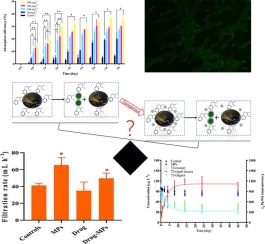当前位置:
X-MOL 学术
›
Environ. Int.
›
论文详情
Our official English website, www.x-mol.net, welcomes your
feedback! (Note: you will need to create a separate account there.)
How microplastics affect chiral illicit drug methamphetamine in aquatic food chain? From green alga (Chlorella pyrenoidosa) to freshwater snail (Cipangopaludian cathayensis).
Environment International ( IF 10.3 ) Pub Date : 2020-01-18 , DOI: 10.1016/j.envint.2020.105480 Han Qu 1 , Ruixue Ma 2 , Holly Barrett 3 , Bin Wang 1 , Jiajun Han 3 , Fang Wang 1 , Pin Chen 1 , Wei Wang 1 , Guilong Peng 1 , Gang Yu 1
Environment International ( IF 10.3 ) Pub Date : 2020-01-18 , DOI: 10.1016/j.envint.2020.105480 Han Qu 1 , Ruixue Ma 2 , Holly Barrett 3 , Bin Wang 1 , Jiajun Han 3 , Fang Wang 1 , Pin Chen 1 , Wei Wang 1 , Guilong Peng 1 , Gang Yu 1
Affiliation

|
The biological impacts of microplastics on many organisms have been well documented. However, the combined effects of microplastics and chiral chemicals on the aquatic food chain are less clear. In the present study, the enantioselective environmental behaviors of methamphetamine co-exposed with microplastics through an aquatic food chain (from Chlorella pyrenoidosa to Cipangopaludian cathayensis) have been investigated in a laboratory environment. It was found that the acute toxicity of methamphetamine against these two species was significantly increased in the presence of microplastics: Chlorella pyrenoidosa showed an EC50 shift from 0.77 to 0.32 mg L-1, while cipangopaludian cathayensis showed an LC50 shift from 4.15 to 1.48 mg L-1, upon the addition of microplastics as a co-contaminant with methamphetamine. Upon exposure to methamphetamine and microplastics, the oxidative damage of algae (19.9 to 36.8 nmol mgprot-1), apoptosis (increase about 2.17 times) and filtration rate (41.2 to 65.4 mL h-1) of snails were observably higher when compared to exposure to methamphetamine alone. After ingestion and accumulation of microplastics, the enantioselectivity, BCFs, BMFs, and distribution of methamphetamine were significantly altered. These results provide evidence that the co-occurrence of microplastics and the chiral drug methamphetamine may increase the burden on aquatic species, with potential further impacts throughout aquatic food chain.
中文翻译:

微塑料如何影响水生食物链中的手性非法药物甲基苯丙胺?从绿藻(Chlorella pyrenoidosa)到淡水蜗牛(Cipangopaludian cathayensis)。
微塑料对许多生物的生物学影响已得到充分证明。但是,微塑料和手性化学品对水生食物链的综合影响尚不清楚。在本研究中,已经在实验室环境中研究了甲基苯丙胺与微塑料通过水生食物链(从小球藻到Cipangopaludian cathayensis)共暴露的对映选择性环境行为。已发现,在存在微塑料的情况下,甲基苯丙胺对这两个物种的急性毒性显着增加:小球藻小球藻的EC50值从0.77变为0.32 mg L-1,而cip草中的LC50的LC50值从4.15变为1.48 mgL。 -1,加入微塑料作为与甲基苯丙胺的共同污染物。暴露于甲基苯丙胺和微塑料时,与暴露相比,蜗牛的藻类氧化损伤(19.9至36.8 nmol mgprot-1),细胞凋亡(增加约2.17倍)和过滤速率(41.2至65.4 mL h-1)明显更高。去甲基苯丙胺。摄入并积累了微塑料后,对映选择性,BCF,BMF和甲基苯丙胺的分布均发生了显着变化。这些结果提供了证据,表明微塑料和手性药物甲基苯丙胺的共存可能会增加水生生物的负担,并可能对整个水生食物链产生进一步的影响。与仅暴露于甲基苯丙胺相比,蜗牛的含量高出4 mL h-1)。摄入并积累了微塑料后,对映选择性,BCF,BMF和甲基苯丙胺的分布均发生了显着变化。这些结果提供了证据,表明微塑料和手性药物甲基苯丙胺的共存可能会增加水生生物的负担,并可能对整个水生食物链产生进一步的影响。与仅暴露于甲基苯丙胺相比,蜗牛的含量高出4 mL h-1)。摄入并积累了微塑料后,对映选择性,BCF,BMF和甲基苯丙胺的分布均发生了显着变化。这些结果提供了证据,表明微塑料和手性药物甲基苯丙胺的共存可能会增加水生生物的负担,并可能对整个水生食物链产生进一步的影响。
更新日期:2020-01-21
中文翻译:

微塑料如何影响水生食物链中的手性非法药物甲基苯丙胺?从绿藻(Chlorella pyrenoidosa)到淡水蜗牛(Cipangopaludian cathayensis)。
微塑料对许多生物的生物学影响已得到充分证明。但是,微塑料和手性化学品对水生食物链的综合影响尚不清楚。在本研究中,已经在实验室环境中研究了甲基苯丙胺与微塑料通过水生食物链(从小球藻到Cipangopaludian cathayensis)共暴露的对映选择性环境行为。已发现,在存在微塑料的情况下,甲基苯丙胺对这两个物种的急性毒性显着增加:小球藻小球藻的EC50值从0.77变为0.32 mg L-1,而cip草中的LC50的LC50值从4.15变为1.48 mgL。 -1,加入微塑料作为与甲基苯丙胺的共同污染物。暴露于甲基苯丙胺和微塑料时,与暴露相比,蜗牛的藻类氧化损伤(19.9至36.8 nmol mgprot-1),细胞凋亡(增加约2.17倍)和过滤速率(41.2至65.4 mL h-1)明显更高。去甲基苯丙胺。摄入并积累了微塑料后,对映选择性,BCF,BMF和甲基苯丙胺的分布均发生了显着变化。这些结果提供了证据,表明微塑料和手性药物甲基苯丙胺的共存可能会增加水生生物的负担,并可能对整个水生食物链产生进一步的影响。与仅暴露于甲基苯丙胺相比,蜗牛的含量高出4 mL h-1)。摄入并积累了微塑料后,对映选择性,BCF,BMF和甲基苯丙胺的分布均发生了显着变化。这些结果提供了证据,表明微塑料和手性药物甲基苯丙胺的共存可能会增加水生生物的负担,并可能对整个水生食物链产生进一步的影响。与仅暴露于甲基苯丙胺相比,蜗牛的含量高出4 mL h-1)。摄入并积累了微塑料后,对映选择性,BCF,BMF和甲基苯丙胺的分布均发生了显着变化。这些结果提供了证据,表明微塑料和手性药物甲基苯丙胺的共存可能会增加水生生物的负担,并可能对整个水生食物链产生进一步的影响。









































 京公网安备 11010802027423号
京公网安备 11010802027423号